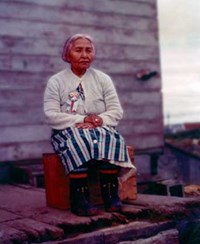- Boston African American National Historic Site (140)
- Boston National Historical Park (82)
- Belmont-Paul Women's Equality National Monument (78)
- National Mall and Memorial Parks (62)
- Women's Rights National Historical Park (54)
- Golden Gate National Recreation Area (47)
- Cuyahoga Valley National Park (36)
- César E. Chávez National Monument (36)
- Homestead National Historical Park (32)
- Show More ...
- National Register of Historic Places Program (50)
- Geologic Resources Division (16)
- National Historic Landmarks Program (13)
- National Heritage Areas Program (10)
- Network to Freedom (8)
- National Trails Office - Regions 6, 7, 8 (6)
- San Francisco Bay Area Inventory & Monitoring Network (6)
- Archeology Program (4)
- Harpers Ferry Center (4)
- Show More ...
Showing 2,018 results for Spiritual Movement ...
Edmund Jackson
St. Clement’s Island Museum
- Type: Place
Discover the St Clement’s Island Museum where Maryland's founding story comes to life. Explore exhibits that highlight the rich history of the Piscataway People and early settlers. Stand on the historic island where the first English settlers landed in 1634, accessible by water taxi. Experience the beauty of the Potomac River and immerse yourself in the culture that shaped the Chesapeake Bay. Don’t miss the chance to learn and explore this unique site in St. Mary’s County.
Rosina Corrothers Tucker
- Type: Person
A prominent advocate for labor and civil rights, Rosina Corrothers Tucker played an integral role in the creation of the Brotherhood of Sleeping Car Porters and its International Ladies Auxiliary. She served as a leader in the Auxiliary for several decades and played a role in planning the March on Washington movement in the 1940s.
Spring 2025: Ballet Folklorico
- Type: Place
Step aboard Pride II, a reproduction Baltimore Clipper, and sail into the Chesapeake’s maritime past. Explore its history from privateering in the War of 1812 to life on the Bay today. Tour the deck or set sail for a hands-on adventure! As part of the NPS Chesapeake Gateways, Pride II offers a unique way to experience the Bay’s seafaring heritage.
Road to the Sea Wayside
Caretaker's Cabin
Mound City Group
- Type: Place
Mound City Group is the smallest of the Hopewell sites in Ross County, but it very well may contain the largest stories of this remarkable culture. The site is home to the park's only visitor center. Grounds are open every day from dawn to dusk while the visitor center building maintains regular hours of operation.
Creating Cuyahoga Valley National Park: 50 Moments That Tell the Story
- Type: Article
In honor of our 50th anniversary year in 2025, Cuyahoga Valley National Park is highlighting 50 key events that help define who and what we are. They showcase the many partners that have come together to preserve open space, create opportunities for recreation, clean up pollution, restore habitats, and save historic resources.
Eliphalet W. Jackson
- Type: Person
Clergyman and merchant Eliphalet W. Jackson participated in the abolition and temperance movements and served on the 1850 Boston Vigilance Committee.
Thomas Hunter
- Type: Person
Boston paper hanger Thomas Hunter served on the 1850 Boston Vigilance Committee.
Greyhound Bus Depot
Port Royal State Historic Park
- Type: Place
“...the people…are moving not from choice to an unknown region not desired by them.” Elijah Hicks wrote these words to Chief John Ross while camped at Port Royal, Tennessee in October 1838. Port Royal was the last place over 10,000 Cherokees slept in Tennessee before crossing into Kentucky. They were travelling along the Great Western Road, part of the Northern Route, which ran from Nashville, Tennessee to Missouri. Visitors can walk about a 1/4 mile of that historic roadbed.
- Type: Place
Greenwich Village Historic District’s reputation for dynamism can be attributed to its history of emerging artists and writers as well as the political unrest and activism of its inhabitants. With the rise of the counterculture movement during the 1960s, Greenwich Village’s Washington Square Park became a hub for writers and musicians. In 1969, LGB residents of Greenwich Village pushed back against police harassment at the Stonewall Inn.
Pelagia Melgenak
- Type: Person
To learn the story of Pelagia (also spelled Palakia) Melgenak is to learn the sanctity of shared traditions, the loving bonds of kinship and the reverence of a spiritual connection to the land around you. Born in the late 1870s in the remote village of Savonoski in Alaska, Pelagia grew up learning about hunting, gathering, navigating and guiding in the area. That all changed in 1912 with the hot ash falling like a blanket covering the region with the eruption of Novarupta.
Marching for Justice in the Fields
- Type: Article
The farm workers who marched from Delano to Sacramento represented the large, seasonal labor force, composed overwhelmingly of people of color, whose labor made California’s thriving agricultural industry possible. Although their labor produced fortunes from the soil, they were subjected to poor wages and working conditions. This article is an introduction to the issues that motivated the Delano Grape Strike and the 1966 march.
Thirty Years of Farmworker Struggle
- Type: Article
Labor organizing has a long history in agriculture. Between 1930 and 1960, diverse groups of farmworkers in California struggled to form unions and to take collective action for better wages and working conditions. This article highlights the political and legal structures that made organizing in the fields especially difficult.
The Terrain of Farmworker Life
- Type: Article
Large-scale commercial agriculture or agribusiness has shaped the landscape of California's Central Valley for over a century. This article explores the social and economic world created by agribusiness in and around the small city of Delano, with an emphasis on the lives of the predominately Filipino, Mexican, and Mexican American farm workers and their families.
A New Era of Farmworker Organizing
- Type: Article
This article explores changes in farm work and farmworker organizing that took place in the 1960s. The end of the Bracero Program, a strike wave, and the emergence of the Black Freedom Movement, all played a role in expanding the opportunities for farmworker organizing. So too did the emergence of a new organization, the National Farm Workers Association.


















